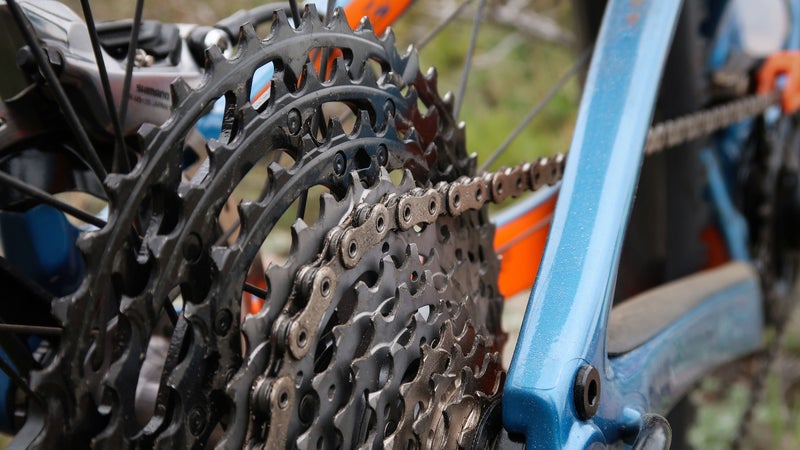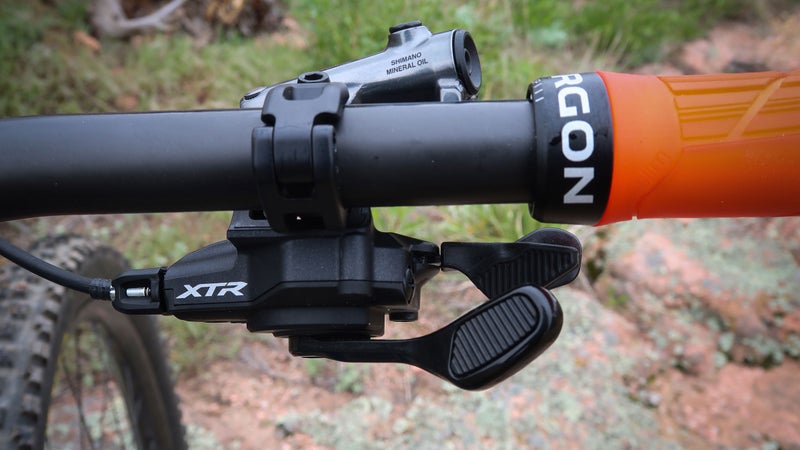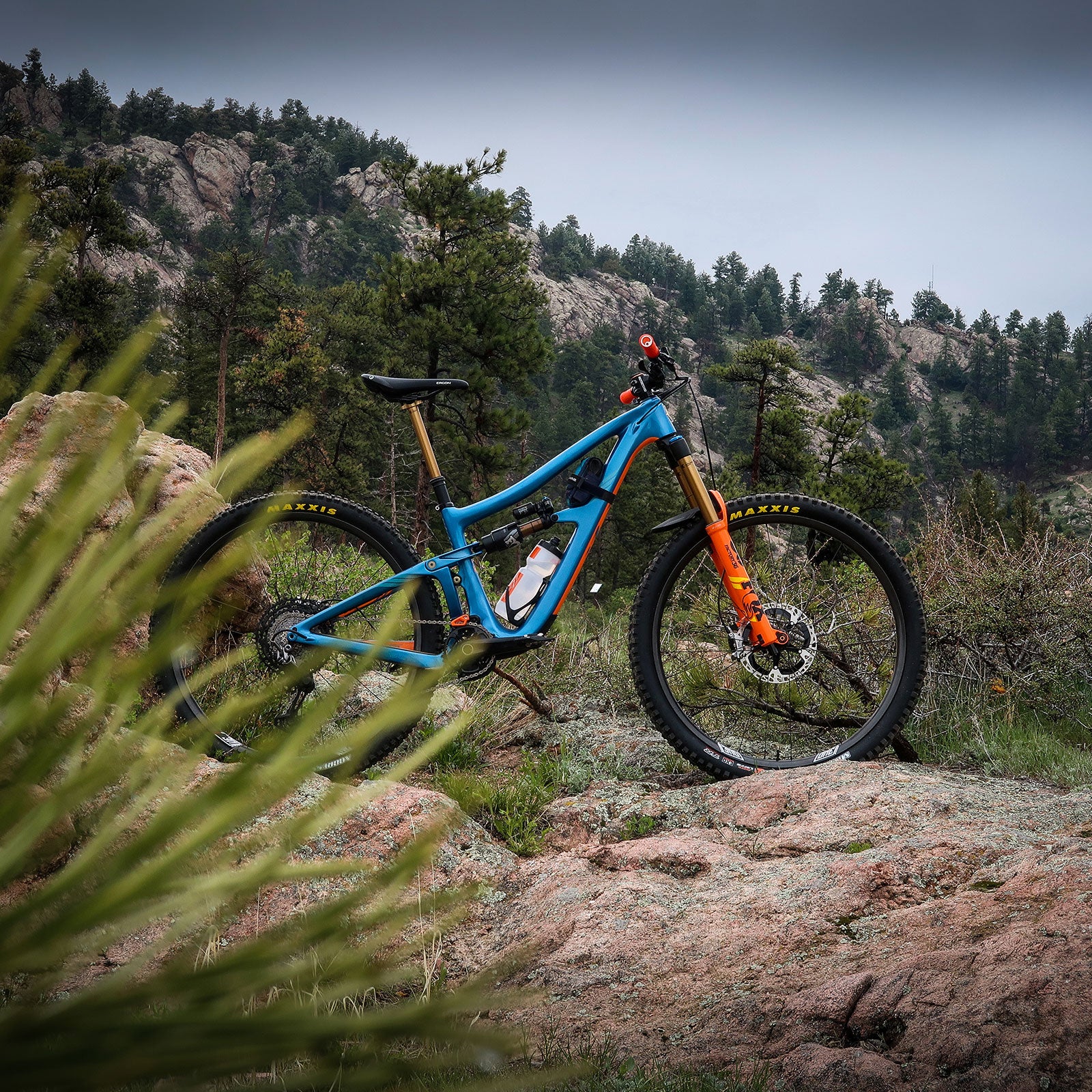Shimano has been playing catch-up to archrival SRAM since single-chainring drivetrains became the norm on modern mountain bikes. Simplicity, lower weights, and the ability to optimize rear-suspension systems around a narrower range of chainring sizes for better performance are all reasons the front derailleur was laid to rest. SRAM led the charge to 1×11 drivetrains in 2012 and upped the ante with wider-range 1×12 mountain-bike transmissions in 2016. Shimano was slow to adapt, and in a few short years, SRAM became the drivetrain of choice on nearly all high-end mountain bikes.
The latest iteration of Shimano’s premier mountain-bike group makes it clear that, despite several years of reluctance, the Japanese component manufacturer has wholeheartedly embraced single-chainring mountain-bike drivetrains. ($1,662), introduced last year and brought to market this spring, ushers in a wealth of advancements that balance the scales and, in some cases, make this group a better option than SRAM for riders who demand the best.
I spent six months and rode approximately 500 miles testing bikes equipped with XTR, in conditions ranging from dry and dusty Colorado singletrack to lush and loam-filled Pacific Northwest forests. In all instances, the new drivetrain and brakes proved their worth.
Smooth Shifting

Shimano’s XTR outpaces SRAM’s 12-speed mountain-bike transmissions—which include cog sizes from 10 to 50—with an even wider-range 10–51 cassette. According to Shimano, out-gearing the competition by a single tooth on the largest cog wasn’t the point (although it certainly doesn’t hurt). This extra tooth amounts to a 10 percent increase in gear range. On the trail, it was hard to tell the difference between a 50- and 51-tooth granny gear, but what wasn’t difficult to discern as I approached the lowest gear was how much better Shimano’s cog selection is over SRAM’s.
Shimano focused on making smaller steps between gears at the extreme ends of the cassette. On the trail, this results in a less drastic change in cadence when shifting during sprints and more gears to choose from when grinding up steep climbs. SRAM’s jump from the 42-to-50-tooth cog feels drastic in comparison to the smaller 45-to-51-tooth transition on the XTR M9100 cassette. The benefit of having tightly spaced gears at the low end of the cassette quickly became apparent when ascending root-covered and rock-strewn climbs—I had more usable gears to choose from.
Improved Tech

In addition to smarter steps between gears, this XTR group introduces technologies that make shifting under power incredibly smooth. In 1988, Shimano developed its Hyperglide, which guided the chain onto the next-largest cog before completely disengaging from the smaller cog. This advancement dramatically improved performance by making shifting faster and more precise. Yet when it came to firing off shifts into harder gears, such as during a sprint, the chain still dropped from larger to smaller cogs. The result was a punchy feeling that required riders to momentarily take pressure off the pedals as the shift was completed.
It took three decades, but the XTR M9100 solves this issue. Shimano’s brain trust redesigned the profile of the cassette teeth and lengthened the chain’s inner links to swiftly guide it onto smaller cogs. Known as Hyperglide+, this guided shifting in both directions results in rapid and seamless gear changes. It didn’t matter if I was shifting into an easier gear when navigating a steep, techy climb or hammering into harder gears when sprinting out of corners, Hyperglide+ made it damn near idiotproof. In both instances, the XTR was fast, smooth, and accurate. The benefit of all this tech is that I spent less time thinking about gearing and more time focused on the trail.
That said, the feature I came to appreciate most in this new 12-speed group is the multi release, which allows riders to shift into one or two harder gears with a single throw of the cable-release lever. This isn’t new tech from Shimano, but its importance has grown. There are a lot of gears to move through on a 12-speed mountain-bike cassette, and having the ability to shift through more than one in a single motion is great when you need to step on the gas in a hurry. This feature, unique to Shimano, thanks to the company’s ruthlessly protected patents, is what I missed most when I switched back to test bikes equipped with SRAM Eagle drivetrains.
Better Braking

In addition to the drivetrain, this XTR group gets two new brake systems. The lightweight two-piston model is designed for cross-country racing, while the four-piston model I tested is targeted to meet the more demanding braking needs of aggressive trail riders and enduro racers.
Shimano refined both systems to be more consistent under hard braking. It achieved this by moving the handlebar clamp from the end to the center of the lever body and adding a brace that sits against the handlebar. This arrangement prevents the lever body from flexing when it’s pulled. According to Shimano, the four-piston brakes have the same power as the company’s Saint stoppers, designed for bike-park riding and downhill racing but with a more gradual onset of braking power.
My experience backed up Shimano’s claim of the four-piston brake being a better fit for trail and enduro riding. The broad range of modulation allowed for subtle feathering, which I found very useful when navigating tight turns and switchbacks. I was able to keep my speed in check without worrying about locking up the wheels, skidding through turns, or going ass over tea kettle on steep descents—all good things.
It appears Shimano took a page out of SRAM’s playbook and attempted to mimic the feel of its competitor’s lauded Code RSC brakes. But having spent time testing SRAM and Shimano systems back to back, I feel SRAM still holds the edge in terms of overall brake performance—its Code and Guide G2 systems still have a wider range of modulation.
The Upshot
Is XTR worth the money? Well, it’s a premium product with a price tag to match. Shifting was flawless throughout my testing, and the brakes provided consistent stopping power in all conditions.
Luckily, for most of us riders looking to make the switch, the technology is already trickling down to Shimano’s workhorse XT and SLX groups. This summer, the brand introduced it in these more affordable drivetrains, which eschew exotic materials and complex manufacturing processes to keep prices in check.
As Shimano’s flagship mountain-bike drivetrain line, XTR is strong, light, and certainly not cheap. If you absolutely must have the best, it’s hard to argue with its impeccable performance. But if you’re like me and care about not paying out the nose just to shave a few grams from your bike, it’s better to invest in the latest .


